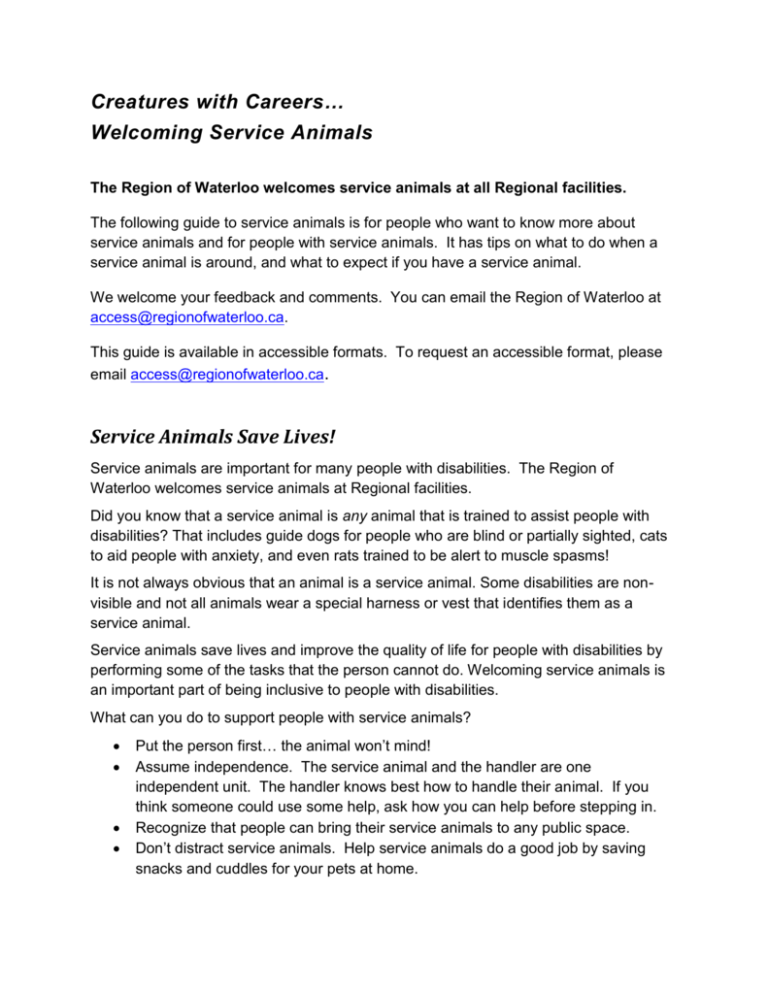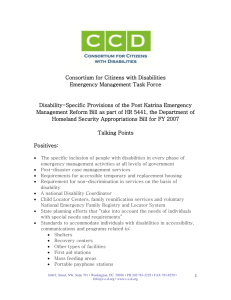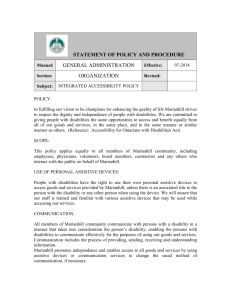What is a service animal?
advertisement

Creatures with Careers… Welcoming Service Animals The Region of Waterloo welcomes service animals at all Regional facilities. The following guide to service animals is for people who want to know more about service animals and for people with service animals. It has tips on what to do when a service animal is around, and what to expect if you have a service animal. We welcome your feedback and comments. You can email the Region of Waterloo at access@regionofwaterloo.ca. This guide is available in accessible formats. To request an accessible format, please email access@regionofwaterloo.ca. Service Animals Save Lives! Service animals are important for many people with disabilities. The Region of Waterloo welcomes service animals at Regional facilities. Did you know that a service animal is any animal that is trained to assist people with disabilities? That includes guide dogs for people who are blind or partially sighted, cats to aid people with anxiety, and even rats trained to be alert to muscle spasms! It is not always obvious that an animal is a service animal. Some disabilities are nonvisible and not all animals wear a special harness or vest that identifies them as a service animal. Service animals save lives and improve the quality of life for people with disabilities by performing some of the tasks that the person cannot do. Welcoming service animals is an important part of being inclusive to people with disabilities. What can you do to support people with service animals? Put the person first… the animal won’t mind! Assume independence. The service animal and the handler are one independent unit. The handler knows best how to handle their animal. If you think someone could use some help, ask how you can help before stepping in. Recognize that people can bring their service animals to any public space. Don’t distract service animals. Help service animals do a good job by saving snacks and cuddles for your pets at home. If you have a service animal, and the animal does not wear a noticeable vest or harness saying that it is a service animal, you may be asked to show identification that the animal is needed for reasons of a disability. Under the Accessibility for Ontarians with Disabilities Act businesses and organizations can ask for a note from a doctor or nurse stating that you need your animal because of a disability. If there is a conflict between a customer with a service animal and a customer who has an allergy or a phobia to animals, the Region of Waterloo will work with all customers to be sure that everyone has access to Regional services and facilities. Service Animals Work! Don’t Distract or Interact The following Words of Advice and Frequently Asked Questions have been adapted with permission from Guide Dogs for the Blind. Visit their website at www.guidedogs.com Meeting a Service Animal: Words of Advice A service animal can be any animal, big or small, that helps someone with a disability to do daily tasks. These include dogs that guide someone who is blind or with partial sight, dogs that retrieve things for someone with limited mobility or other small animals trained to detect seizures. The following tips can help you know what to do when you notice guide dogs or other service animals in the community. When you notice someone who is blind using a guide dog, it may be tempting pet the guide dog. But remember that this dog is responsible for leading someone who cannot see. The dog should never be distracted from that job. A person's safety may depend on their dog's alertness and concentration. It is okay to ask someone if you may pet their service animal. Many people enjoy introducing their animals when they have the time. Always ask first. The animal’s primary responsibility is to its partner or handler and it is important that the animal not expect attention from others. A service animal should never be offered food or other distracting treats. The animals are fed on a schedule and follow a specific diet in order to keep them in optimum condition. Even slight changes from their routine can disrupt their regular eating and relieving schedules and seriously inconvenience their handlers. Service animals are trained to resist offers of food so they will be able to visit restaurants without begging. Feeding treats to a guide dog weakens this training. Although guide dogs cannot read traffic signals, they are responsible for helping their handlers safely cross a street. Calling out to a guide dog or intentionally obstructing its path can be dangerous for the dog and it’s handler as it could break the dog's concentration on its work. Listening for traffic flow has become harder for guide dog handlers because of quieter car engines and the increasing number of cars on the road. Please don't honk your horn or call out from your car to signal when it is safe to cross. This can be distracting and confusing. Be especially careful of pedestrians in crosswalks when making right-hand turns at red lights. It's not all work and no play for a service animal. When they are not in harness or on duty they are treated in much the same way as pets. However, for their safety they are only allowed to play with specific toys. Please don't offer them toys without first asking their handler's permission. In some situations, working with a service animal may not be appropriate. Instead, someone who is partially sighted may prefer to take your arm just above the elbow and allow their dog to heel. Others will prefer to have their dog follow you. In this case, be sure to talk to the handler and not the dog when giving directions for turns. A service animal can make mistakes and will need reminders to maintain its training. Correcting a mistake usually involves a time-out or leash action. When the animal regains focus and correctly follows a cue, he or she is frequently praised and rewarded with a kibble. Service animal handlers have been taught appropriate management methods to use with their animals. Access laws, including Canada's Blind Persons' Rights Act, permit people who are blind to be accompanied by their guide dogs anywhere the general public is allowed, including taxis and buses, restaurants, theatres, stores, schools, hotels, apartment and office buildings. The Accessibility for Ontarians with Disabilities Act Customer Service Regulation also allows any person with a disability to be accompanied by their service animal wherever the public is allowed, unless excluded by another law. The Health Protection and Promotion Act allows service dogs in areas where food serviced, offered for sale, or sold. This means service dogs are allowed in restaurants and grocery stores. Before asking a question of a person handling a service animal, allow them to complete the task at hand. Remain calm in your approach and mannerisms. Never tease an animal. Say Yes to Service Animals! Frequently Asked Questions for Businesses Regarding Access for Service Animals Please note: The following is not legal advice. For more information, please consult the Ontario Human Rights Code, the Accessibility for Ontarians with Disabilities Act, and seek legal advice. Q: What are the laws that apply to my business? Under the Ontario Human Rights Code, privately owned businesses that serve the public, such as restaurants, hotels, retail stores, taxicabs, theatres, concert halls, and sports facilities, are prohibited from discriminating against individuals with disabilities. The Accessibility for Ontarians with Disabilities Act Customer Service Regulation requires these businesses to allow people with disabilities to bring their service animals onto business premises in whatever areas customers are generally allowed. Q: What is a service animal? A service animal as any guide dog, signal dog, or other animal individually trained to provide assistance to an individual with a disability. Animals may be considered service animals regardless of whether they have been licensed or certified by a school or training facility. Service animals perform some of the functions and tasks that the individual with a disability cannot perform for him or herself. Guide dogs are one type of service animal, used by some people who are blind. This is the type of service animal with which most people are familiar. But there are service animals that assist persons with other kinds of disabilities in their day-to-day activities. Some examples include: Alerting people who are hard of hearing to sounds. Pulling wheelchairs or carrying and picking up things for persons with limited mobility. Assisting persons with limited mobility with balance. Detecting and alerting people of oncoming seizures. Comfort and emotional support. Q: How can I tell if an animal is really a service animal and not just a pet? Some, but not all, service animals wear special collars and harnesses. Some, but not all, are licensed or certified and have identification papers. Sometimes, but not always, it is obvious that a person with the service animal has a disability. However, because not all disabilities are visible, and not all service animals wear a harness or have identification papers, it can be difficult to know if an animal is a service animal. If you are not certain that an animal is a service animal, you may ask the person who has the animal if it is a service animal required because of a disability. It is important to remember you cannot ask someone if they have a disability or about the nature of their disability. Under the Accessibility for Ontarians with Disabilities Act Customer Service Regulation if it is not readily apparent (you cannot tell the person has a disability or that the animal is a service animal) people with service animals can be asked to show a note from a doctor a nurse stating that the animal is a service animal, and needed for reasons a disability. Q: What must I do when an individual with a service animal comes to my business? The service animal must be permitted to accompany the individual with a disability to all areas of the facility where customers are normally allowed to go. An individual with a service animal may not be segregated from other customers, or from their service animal. Q: I have always had a clearly posted "no pets" policy at my establishment. Do I still have to allow service animals? Yes. A service animal is not a pet. You may wish to modify your "no pets" policy to allow the use of a service animal by a person with a disability. This does not mean you must abandon your "no pets" policy altogether but simply that you must make an exception to your general rule for service animals. Q: Am I responsible for the animal while the person with a disability is in my business? No. The care or supervision of a service animal is solely the responsibility of his or her owner. You are not required to provide care or food or a special location for the animal. If you have questions about service animals or the Accessibility for Ontarians with Disabilities Act, you may contact the Accessibility Directorate of Ontario at www.accesson.ca or 1-866-515-2025 (telephone) or 1-800-268-7095 (TTY). Other Resources Service animals are not regulated, and so there is no single place for information on service animals. Contact local organizations in your area that work with people with disabilities. They may have information about service animals. You may want to start you research with some of the agencies below. Canadian National Institute for the Blind (CNIB): www.cnib.ca Canadian Hearing Society (CHS): www.chs.ca Independent Living Centre – Waterloo Region: www.ilcwr.org National Service Dogs: www.nsd.on.ca You can also look in the Yellow Pages (www.yellowpages.ca) under Social and Human Service Organizations for the names of other local organizations that work with people with disabilities.








